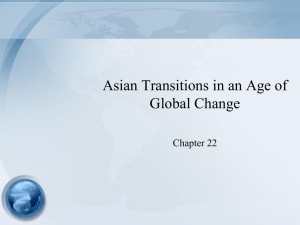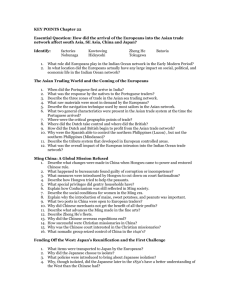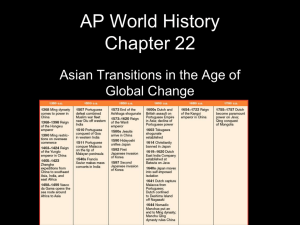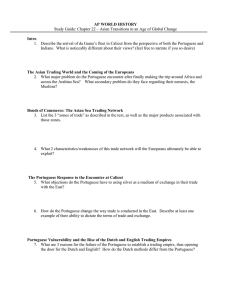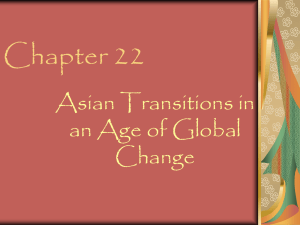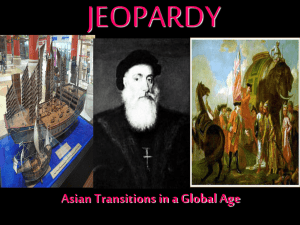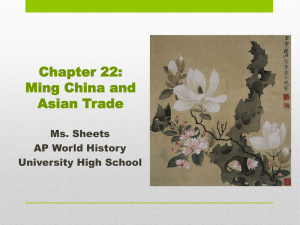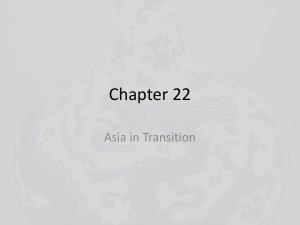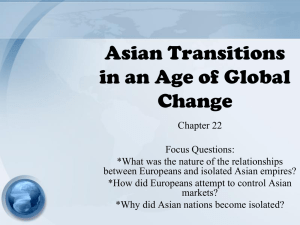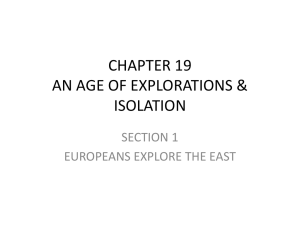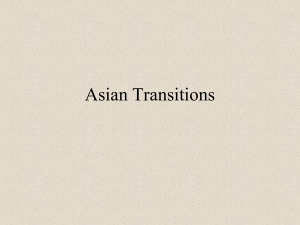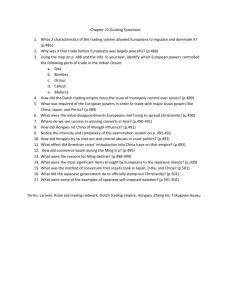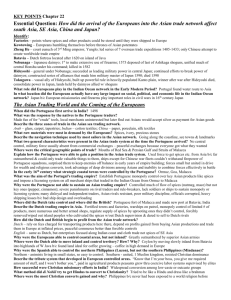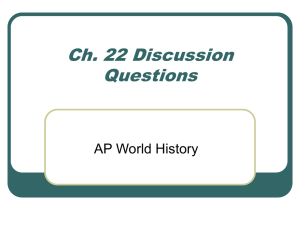Chapter 22 Review - Davis School District
advertisement
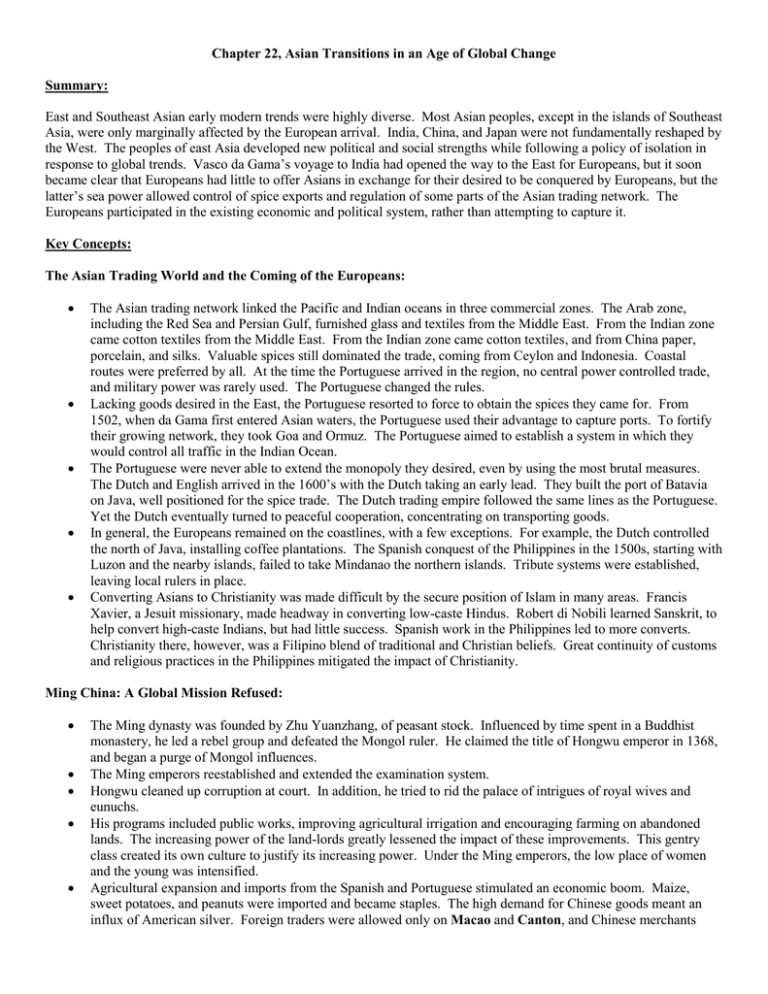
Chapter 22, Asian Transitions in an Age of Global Change Summary: East and Southeast Asian early modern trends were highly diverse. Most Asian peoples, except in the islands of Southeast Asia, were only marginally affected by the European arrival. India, China, and Japan were not fundamentally reshaped by the West. The peoples of east Asia developed new political and social strengths while following a policy of isolation in response to global trends. Vasco da Gama’s voyage to India had opened the way to the East for Europeans, but it soon became clear that Europeans had little to offer Asians in exchange for their desired to be conquered by Europeans, but the latter’s sea power allowed control of spice exports and regulation of some parts of the Asian trading network. The Europeans participated in the existing economic and political system, rather than attempting to capture it. Key Concepts: The Asian Trading World and the Coming of the Europeans: The Asian trading network linked the Pacific and Indian oceans in three commercial zones. The Arab zone, including the Red Sea and Persian Gulf, furnished glass and textiles from the Middle East. From the Indian zone came cotton textiles from the Middle East. From the Indian zone came cotton textiles, and from China paper, porcelain, and silks. Valuable spices still dominated the trade, coming from Ceylon and Indonesia. Coastal routes were preferred by all. At the time the Portuguese arrived in the region, no central power controlled trade, and military power was rarely used. The Portuguese changed the rules. Lacking goods desired in the East, the Portuguese resorted to force to obtain the spices they came for. From 1502, when da Gama first entered Asian waters, the Portuguese used their advantage to capture ports. To fortify their growing network, they took Goa and Ormuz. The Portuguese aimed to establish a system in which they would control all traffic in the Indian Ocean. The Portuguese were never able to extend the monopoly they desired, even by using the most brutal measures. The Dutch and English arrived in the 1600’s with the Dutch taking an early lead. They built the port of Batavia on Java, well positioned for the spice trade. The Dutch trading empire followed the same lines as the Portuguese. Yet the Dutch eventually turned to peaceful cooperation, concentrating on transporting goods. In general, the Europeans remained on the coastlines, with a few exceptions. For example, the Dutch controlled the north of Java, installing coffee plantations. The Spanish conquest of the Philippines in the 1500s, starting with Luzon and the nearby islands, failed to take Mindanao the northern islands. Tribute systems were established, leaving local rulers in place. Converting Asians to Christianity was made difficult by the secure position of Islam in many areas. Francis Xavier, a Jesuit missionary, made headway in converting low-caste Hindus. Robert di Nobili learned Sanskrit, to help convert high-caste Indians, but had little success. Spanish work in the Philippines led to more converts. Christianity there, however, was a Filipino blend of traditional and Christian beliefs. Great continuity of customs and religious practices in the Philippines mitigated the impact of Christianity. Ming China: A Global Mission Refused: The Ming dynasty was founded by Zhu Yuanzhang, of peasant stock. Influenced by time spent in a Buddhist monastery, he led a rebel group and defeated the Mongol ruler. He claimed the title of Hongwu emperor in 1368, and began a purge of Mongol influences. The Ming emperors reestablished and extended the examination system. Hongwu cleaned up corruption at court. In addition, he tried to rid the palace of intrigues of royal wives and eunuchs. His programs included public works, improving agricultural irrigation and encouraging farming on abandoned lands. The increasing power of the land-lords greatly lessened the impact of these improvements. This gentry class created its own culture to justify its increasing power. Under the Ming emperors, the low place of women and the young was intensified. Agricultural expansion and imports from the Spanish and Portuguese stimulated an economic boom. Maize, sweet potatoes, and peanuts were imported and became staples. The high demand for Chinese goods meant an influx of American silver. Foreign traders were allowed only on Macao and Canton, and Chinese merchants fared well. In imitation of the gentry, merchants invested in land. The fine arts flourished as well, mainly along traditional lines. The novel achieved its classic form. Under Emperor Yunglo, admiral Zenghe led seven expeditions to the west. The size and scope of these undertakings demonstrated the Chinese capacity to undertake global expansion. Yet the Chinese retreated instead, closing themselves off more firmly than ever. Missionaries to china such as Matteo Ricci and Alan Schall, chose to convert the country from the top down, but they met with little success. Toward the end of the 16th century, the Ming court was weakened by corruption, and the rulers distanced themselves from the people. Public works lapsed, and disaffected farmers turned to banditry. Rebellion brought the Ming dynasty down in 1644, when the last emperor hanged himself to avoid capture. Fending Off the West: Japan’s Reunification and the First Challenge: A series of military rulers brought an end to daimyo warfare in Japan. The first, Nobunaga, used European firearms to depose the Ashikaga shogun in 1513. After his death, Toyotomi Hideyoshi pursued his predecessor’s killers. Ambitious as well as able, Hideyoshi undertook the conquest of Korea, but failed. His successor, Tokugawa Ieyasu, was acknowledged shogun by the Emperor. Ruling from Edo, the Tokugawa shoguns ended daimyo warfare. European contacts with Japan were increasing in the period of unification, and indeed influenced events. In their own way, firearms and commerce each helped the Tokugawa rulers. Nobunaga patronized Christian missionaries, hoping to lessen the power of militant Buddhist orders. However, under Hideyoshi, Christians came to be seen as a threat. Hideyoshi expelled the Christian missionaries and then persecuted their converts. Ieyasu went further, attempting to rid the islands of all Europeans. By the mid-17th century, European contact was limited to Dutch trade on Deshima Island. In this climate, the School of National Learning focused on the uniqueness of Japanese history and culture. Key Terms: Malacca Dutch Trading Empire Caravels Forbidden City Manchu Hongwu Tokugawa Ieyasu Edo Nobunaga Deshima Essay Questions: Asian Transitions in an Age of Global Change 1. Define the characteristics of the Asian sea trading network. In what ways did the European incursion change the Asian system? 2. What was the nature of the Ming restoration of traditional Chinese values? What innovations were made? 3. Compare and contrast Chinese and European means and motives for commercial expansion. 4. Following the establishment of the Tokugawa shogunate, what was the nature of Japanese isolation? 5. Evaluate the impact of the European entry into the Asian sea trading network.
